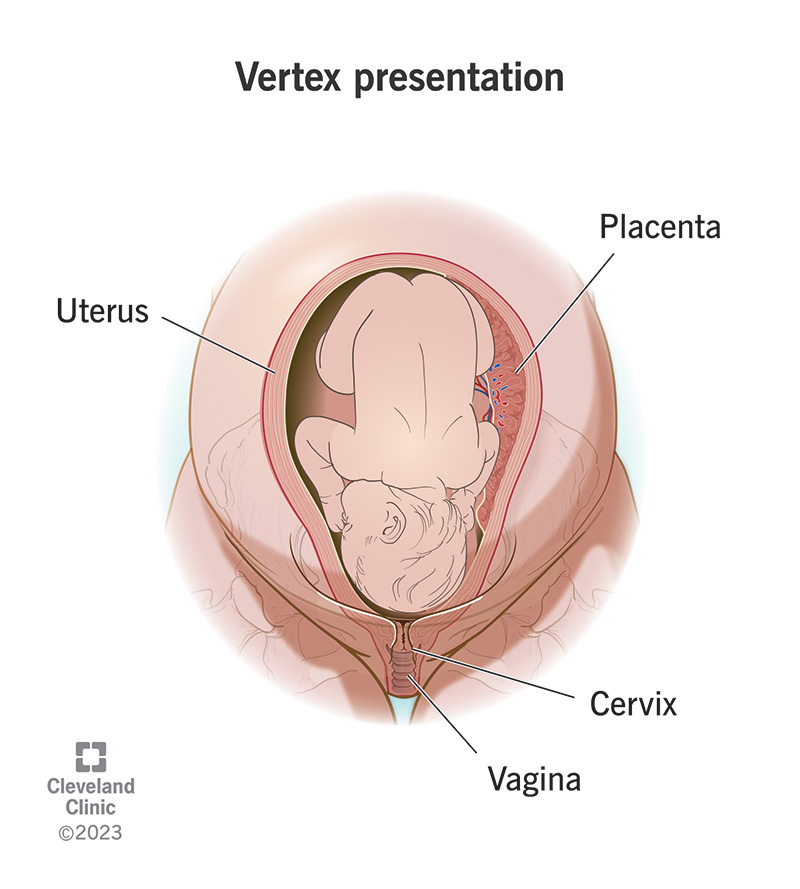A vertex presentation is the ideal position for a fetus to be in for a vaginal delivery. It means the fetus is head down, headfirst and facing your spine with its chin tucked to its chest.

The vertex presentation describes the orientation a fetus should be in for a safe vaginal delivery. It becomes important as you near your due date because it tells your pregnancy care provider how they may need to deliver your baby. Vertex means “crown of the head.” This means that the crown of the fetus’s head is presenting towards the cervix.
A vertex presentation means a fetus is in a headfirst, head down position with its chin tucked towards its chest, facing your spine.
No, the fetus being in a vertex presentation doesn’t indicate labor is near.
Yes, they essentially mean the same thing. Cephalic presentation means a fetus is in a head-down position. Vertex refers to the fetus’s neck being tucked in. There are other types of cephalic presentations like brow and face. These mainly describe how the fetus’s neck is flexed.
Most fetuses settle into a presentation around 32 to 36 weeks of pregnancy. It’s possible for a fetus to rotate into a cephalic presentation after 36 weeks.
Your pregnancy care provider will check the presentation of the fetus during your prenatal appointments. They do this by feeling around your abdomen for physical landmarks — like a fetus’s bottom and head — using a method called Leopold’s maneuvers. They can also use ultrasound.
Cleveland Clinic is a non-profit academic medical center. Advertising on our site helps support our mission. We do not endorse non-Cleveland Clinic products or services. Policy
A vertex presentation means your baby comes out headfirst through your cervix and out your vagina (or birth canal).
Many decades of research shows a vertex presentation is the safest way to deliver a baby vaginally. Your pregnancy care provider’s goal is to deliver a healthy baby with the least amount of complications. If a baby is in any position other than headfirst, it becomes more challenging to deliver your baby safely during a vaginal delivery.
The most common complication is having a large baby that doesn’t fit through the birth canal. A large baby runs the risk of getting its shoulders or head stuck during delivery if they’re in a vertex position. Most healthcare providers will recommend a C-section if they suspect your baby is too large to fit through your vagina safely.
Breech is when a fetus is presenting in such a way that its feet or bottom would come out of your vagina first.
While a vertex position is ideal, some fetuses settle into a breech position. Keep in mind, a fetus moves freely and can take up until the end of 36 weeks of pregnancy to settle into a vertex position. The fetus’s position becomes critical when you’re nearing your due date and deciding on which method of delivery is safest.
About 3% to 4% of all babies are breech at term. If this occurs, your healthcare provider will talk to you about delivering your baby via C-section. A vaginal delivery for a breech baby comes with too many risks.
In some cases, your provider may discuss turning your baby to a vertex position. This is called external cephalic version or ECV and it involves moving the fetus by pushing on your abdomen. This also comes with risks, so it’s important to discuss the pros and cons with your provider.
Once a fetus turns into a vertex presentation, it rarely switches to a breech position. In rare cases, people with polyhydramnios (excess amniotic fluid) may be at risk for having their baby turn at delivery.
Yes, some pregnancy care providers can turn the fetus to a vertex position. Keep in mind there are many factors that go into deciding to turn a fetus and it’s not guaranteed to work.
Methods for turning your baby can include:
A note from Cleveland Clinic
Hearing your baby is in a vertex presentation may sound confusing, but it’s actually a good thing. It means the fetus has settled into position for a vaginal delivery. And, if the fetus isn’t in a vertex position, try not to worry. There’s usually still time for it to move before delivery. Pregnancy and delivery come with a lot of questions. Don’t be afraid to ask your pregnancy care provider any questions you have throughout the process. They’re there to answer your questions and make sure your childbirth goes as smoothly as possible!
Last reviewed by a Cleveland Clinic medical professional on 05/18/2023.
Learn more about our editorial process.
Cleveland Clinic is a non-profit academic medical center. Advertising on our site helps support our mission. We do not endorse non-Cleveland Clinic products or services. Policy